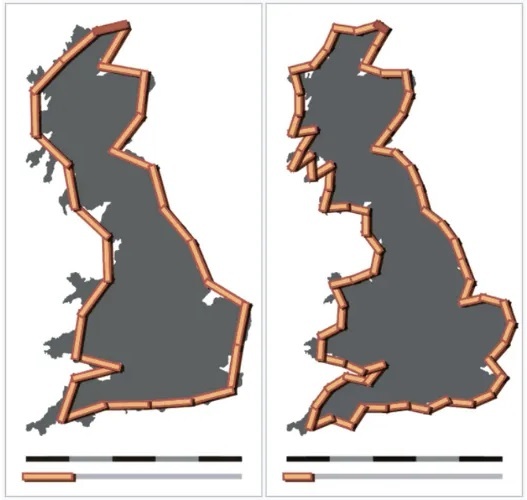‘A Map is not a Blueprint: Why Fixing Nature Fails’
As an author, I know that words matter. That’s why I’ve been mulling over the idea that ‘a map is not a blueprint’ since I read the essay of the same name by Nat Eliason.
To explain the difference between maps and blueprints, Eliason points to this graphic of a map:

The map on the left is a crude outline. The map on the right is more accurate, but neither is a blueprint of the UK because neither can be used to re-create the UK.
The blueprint for a piece of machinery can be used to build that piece of machinery, right down to the last millimetre. I know, because my Dad was an engineer, and he often brought his blueprints home. Those blueprints specified exactly what went where. Maps, even the most detailed ones, can only provide an approximation of the object they represent.
But what does this have to do with nature? I can give you an Aussie answer: cane toads!

‘The cane toad is one of Australia’s best-known introduced pests.
Released in Queensland to help the cane industry deal with insect attacks on sugar cane roots, it has since spread all the way across to northern Western Australia.’
https://www.nma.gov.au/defining-moments/resources/introduction-of-cane-toads
The cane toad is not native to Australia, but in 1932, some clever sod thought it would be a great idea to import some into Australia and see if they worked on cane beetles. Why? Because in their country of origin, cane toads ate the pests that attacked sugar cane. No brainer, right?
Wrong. In the cane toad’s country of origin, there were other beasties that kept the cane toad in check. Australia, being an island continent, has none of those beasties, so guess what? Yup. The cane toad population exploded.
But that’s not the worst of the cane toad problem. The worst part is that any native animal, or even introduced ones like dogs, that try to eat the cane toad end up dying because the toad is poisonous. Lovely. So now we have a massive cane toad problem that’s spread thousands of kilometres from the sugar cane fields of Queensland.
And that, my friends is why a map is not a blueprint. The idiot – Reginald Mungomery – who first brought the cane toad to Australia saw only a tiny part of the whole picture, but it was an even bigger idiot – Prime Minister Joseph Lyons – who threw the precautionary principle right out the window:
Walter Froggatt, a prominent entomologist, was rightly concerned that the toads would become a significant pest. He successfully prevailed on the federal Health Department to ban further releases of the toad.
However, in 1936 Prime Minister Joseph Lyons succumbed to pressure from the Queensland Government and the media to rescind the ban.
https://www.nma.gov.au/defining-moments/resources/introduction-of-cane-toads
Note the words ‘succumbed to pressure’. There are all sorts of pressure: political pressure is one, the profit motive is another. Where science is concerned, both forms of pressure tend to lead to terrible outcomes.
In his essay, Eliason offers the example of trans fats:
Proctor and Gamble had a thriving candlemaking business in the 1800s, but as electricity started spreading, the demand for candles fell dramatically. They primarily used cottonseed oil to make their candles, but as the demand for candles fell, they looked for a new use for their cottonseed oil.
In 1901, a chemist developed a process called “hydrogenation,” which turned liquid oils into solids to help preserve them for longer. It also happened to give cottonseed oil a consistency very similar to lard, the dominant cooking fat of the time, so Procter and Gamble bought the rights to the hydrogenation process, started using it with their cottonseed oil to create a room-temperature stable fat, and then branded it as a cooking product called Crisco.
https://blog.nateliason.com/p/map-not-a-blueprint?publication_id=882098&post_id=141399725&isFreemail=true&r=1i4v12
For those who don’t know, trans fats have a terrible effect on human health.
Eliason puts this one hundred year old debacle down to hubris and ignorance:
They [Proctor and Gamble] thought they had a blueprint, but really they had a map scribbled in crayon.
https://blog.nateliason.com/p/map-not-a-blueprint?publication_id=882098&post_id=141399725&isFreemail=true&r=1i4v12
Personally, I think it was greed. Proctor and Gamble made the science fit their commercial need. That is always a recipe for disaster.
Eliason also points to lobotomies and fertilizer as ‘maps’ rather than ‘blueprints’. I’d like to add AI to the list. There are genuine, life saving uses for AI, but the commercial crap that’s hit us over the last couple of years is just a way for companies to save money and make profits.
Always follow the money.
I’ve provided tons of links to Eliason’s essay, and I implore you to follow them. This is a topic we have to make time for, or we may end up with cane toads all over the place.
Meeks



